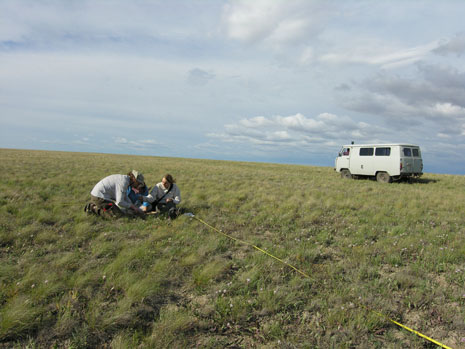Background
Steppe Ecosystems in Kazakhstan - Background
The Eurasian steppe belt, stretching from Ukraine to the Altai mountains, has been the scene of large-scale land-use changes after the collapse of the Soviet Union in 1991, especially in the agricultural sector. Millions of hectares of cereal fields were abandoned, and livestock numbers plummeted resulting in changing grazing patterns. More recently, a recovery in both cereal agriculture and livestock numbers has been observed, leading to increasing land reclamation and intensification in agriculture.
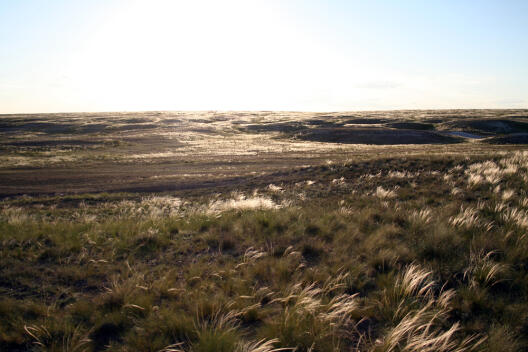
Fruiting feather grass turns the Kazakh steppe into an ocean of liquid silver in late May. (photo: Johannes Kamp)© Johannes Kamp It is likely that these land-use changes had and will have a massive impact on steppe biodiversity, but few quantitative data are available.
In close collaboration with conservation organisations such as the RSPB in the UK and the Association for the Conservation of Biodiversity (ACBK, the Kazakh BirdLife partner), we study how large-scale abandonment, changing grazing patterns but also recent agricultural expansion impact on steppe birds and plant communities. Our results help to develop conservation strategies, design protected areas and promote more sustainable development in agriculture. We also try to develop a deeper understanding of population-ecological processes in natural and semi-natural grasslands.
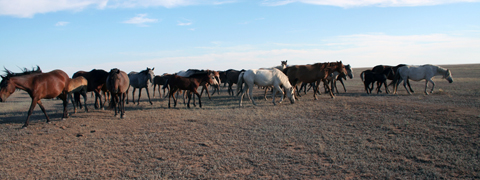
Semi-wild horses graze the steppe and create habitat for many animal species. (photo: Johannes Kamp) Altyn Dala
Altyn Dala: supporting ecosystem-scale conservation in Kazakhstan (2009–2013)
In this project, we investigate the impact of agricultural change on steppe plant and bird communities in order to assess the conservation status of the steppes and give recommendations for conservations strategies in arable landscapes of Central and Northern Kazakhstan. We also analyse governmental statistics and conduct socio-economic research among land-users to predict future land-use trends.
Vegetation ecological methods are used to assess, how fast abandoned croplands reconvert to steppe. First results suggest that this is a slow process, but can be speeded up by grazing the fields with domestic livestock. Some species, such as the characteristic Schrenck’s Tulip Tulipa schrenckii have still not returned and are largely confined to pristine steppe grasslands.
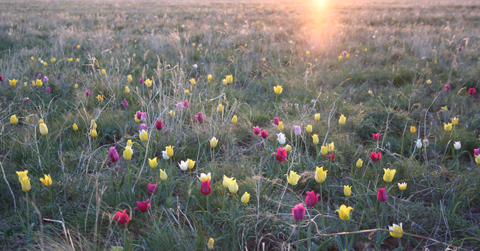
Schrenck’s tulip Tulipa schrenckii (photo: Johannes Kamp) We also study how birds and small mammals (such as sousliks and jerboas) react on abandonment and grazing. We could show that former arable fields provide valuable secondary habitat for a number of steppe birds, and that bird densities here are in fact often higher than on pristine steppe that currently lacks grazing over vast expanses. However, densities vary strongly with small-scale habitat patterns within these fields, and certain age classes of abandoned fields seem to be much preferred over others.
We conclude that large-scale abandonment of agriculture in Kazakhstan massively benefitted the steppe avifauna and plant communities, but predict new declines due to an increasing reclamation of abandoned fields.
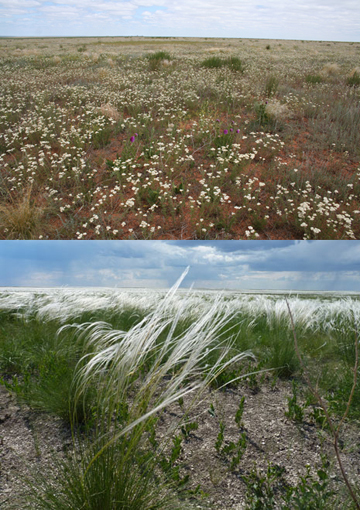
Abandoned fields of different age stages: 4-5 years (above), 15+ years, regrowth after a wildfire (below). (photos: Annika Brinkert) Involved organisations and funders
The Altyn Dala Conservation Initiative (Altyn Dala meaning ‘golden steppe’) is a ecosystem-scale conservation programme in Kazakhstan that was initiated in 2005 by the Kazakh Committee of Forestry and Hunting (CFH) of the Ministry of Agriculture and the Ministry of Environment Protection. It is implemented by the Association for the Conservation of Biodiversity in Kazakhstan (ACBK), the Royal Society for the Protection of Birds (RSPB) and Zoological Society Frankfurt (ZGF). Our group mainly contributes to its vegetation ecological and ornithological components. Our work is funded by the UK government’s Darwin Initiative.

Pallid Harrier, a species that profited strongly from agricultural abandonment. (photo: Maxim Koshkin)© Maxim Koshkin Links
Project description [link [en]]
A related, Darwin-funded project on the Critically Endangered Sociable Lapwing Vanellus gregarius, a steppe endemic [link [en]]Contact
Dr Johannes Kamp (coordination and bird ecology)
Prof. Dr Norbert Hölzel (plant ecology)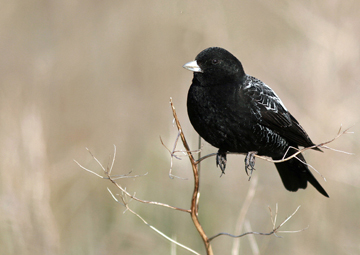
Black Lark male (photo: Paul F. Donald) Black Larks
Black Lark ecology (2013/2014)
The Black Lark Melanocorypha yeltoniensis is an endemic breeder of the Eurasian steppes. Although still widespread, declines have been reported in many regions of Kazakhstan and Russia, and are projected to continue in the future. Reasons for the decline are unknown, but probably linked to population-ecological changes resulting from land-use change during Soviet and post-Soviet times.
In 2011, we discovered that Black Larks (as many other steppe bird species) were superabundant on abandoned cereal fields compared to pristine steppe and used agricultural areas. At the same time, sex-ratios in these habitats were strongly skewed, with a crude estimate of 5 males on one female.
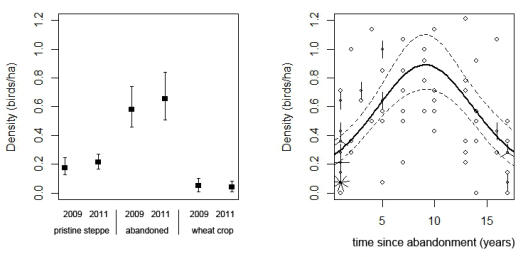
Mean densities of territorial Black Larks in pristine steppe, abandoned and used cropland in 2009 and 2011 (left), and density variation along a gradient of age since abandonment. Based on 171 distance sampling transects in Central Kazakhstan. We also found that female Black Larks collect and carry horse and cattle dung to build large “pavements” around their nests, previously unknown behaviour for this species. This suggests a much closer connection with grazers than previously thought. The use of dung in bird nests has been described for other species as well, but the reasons for and evolutionary benefits of this behaviour are largely unknown.
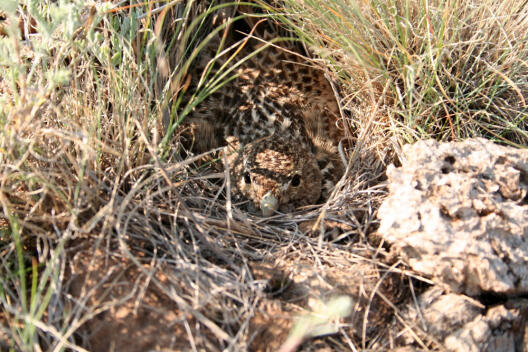
Black Lark female on nest (photo: Johannes Kamp) We use the Black Lark as a model organism to investigate what drives birds into abandoned agricultural areas by studying breeding success, abundance patterns and microhabitat use.
In 2013, we will focus our research on the importance of animal dung for this species: we aim to relate breeding success of females to dung availability and dung characteristics at the nests. Furthermore, we will semi-experimentally test more hypotheses on the use of dung in and around steppe bird nests, namely i) dung distracts predators, ii) dung increases breeding success by better thermal insulation, iii) dung prevents nests from being trampled by domestic livestock and iv) dung increases prey (invertebrate) availability around nests. From this project, we hope to gain insight into the evolutionary reasons of using dung in animal nests. Important for conservation management, we will clarify the influence of grazing management on breeding success of steppe birds.
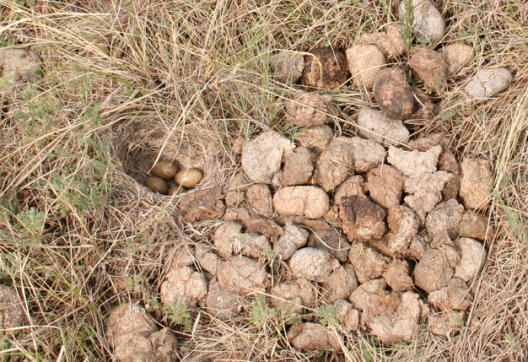
Mohrenlerchennest mit einem Wall aus Pferdeäpfeln, die vom Weibchen im Schnabel herangebracht wurden. (Foto: Ruslan Urazaliev) For updates from the field, please refer to our blog.
Involved organisations and funders
This project is a collaboration between the Universities of Münster (Working Group Ecosystem Research) and the Association for the Conservation of Biodiversity in Kazakhstan (ACBK). It also involves students from the University of Wageningen (NL, Resource Ecology Group) and various universities in Kazakhstan.
We are grateful for generous funding from the British Ornithologists Union (BOU), Deutsche Ornithologen-Gesellschaft (DO-G), the Ornithological Society of the Middle East and Central Asia (OSME) and Förderkreis Allgemeine Naturkunde Biologie e.V. (FAN B) supporting both research and training in Kazakhstan.

Contact
Infothek
Media
Radio
- Listen to a radio feature [de] (in German) about the Darwin-funded Altyn Dala project on Deutschlandradio Wissen
Print
- ’Nesting in the muck’ – a report on the new Black Lark ecology project on birdguides [link [en]]
- Kazakhstan’s steppe birds face new declines – a report covering a paper in Biological Conservation about potential threats for steppe biodiversity by expanding agriculture [link [en]]
- Menschenleere Weiten – an eyewitness account of students from Münster mapping plant communities in Kazakhstan [link [de]]
Finished theses
- Brinkert, Annika (2012) Vegetation development on old fields in the southern steppe zone of Kazakhstan (MSc, University of Münster)
Selected publications
- Buchanan GM, Bond A, Crockford NJ, Kamp J, Pearce-Higgings JW, Hilton G (2017, in press) The potential breeding range of Slender-billed Curlew Numenius tenuirostris identified from stable-isotope analysis. Bird Conservation International 27 [doi: 10.1017/S0959270916000551]
- Palpurina S, Wagner V, von Wehrden H, Hájek M, Hórsak M, Brinkert A, Hölzel N, Wesche K, Kamp J, Hájková P, Danihelka J, Lustyk P, Merunková K, Preislerová Z, Kočí M, Kubešová S, Cheresov M, Ermakov N, German D, Gogoleva P, Lashchynsky N, Martynenko V, Chytrý M (2017) The relationship between plant species richness and soil pH vanishes with increasing aridity across Eurasian dry grasslands. Global Ecology and Biogeography 26 (4): 425–434 [doi:10.1111/geb.12549]
- Wagner V, Chytrý M, Zelený D, von Wehrden H, Brinkert A, Danihelka J, Jansen F, Hölzel N, Kamp J, Lustyk P, Merunková K, Palpurina S, Preislerová Z, Wesche K (2017) Regional differences in soil pH niche among dry grassland plants in Eurasia. Oikos 126(5): 660-670 [doi:10.1111/oik.03369]
- Brinkert A, Hölzel N, Sidorova TV, Kamp J (2016) Spontaneous steppe restoration on abandoned cropland in Kazakhstan: grazing affects successional pathways. Biodiversity and Conservation 25 (12): 2543–2561 [doi: 10.1007/s10531-015-1020-7]
- Kamp J, Koshkin MA, Bragina, Katzner TE, Milner-Gulland EJ, Schreiber D, Sheldon R, Shmalenko A, Smelansky I, Terraube J, Urazaliev R (2016) Persistent and novel threats to the biodiversity of Kazakhstan’s steppes and semi-deserts. Biodiversity and Conservation 25 (12): 2521–2541 [doi:10.1007/s10531-016-1083-0]
- Lameris T, Fijen T, Urazaliev R, Pulikova G, Donald PF, Kamp J (2016) Breeding ecology of the endemic Black Lark Melanocorypha yeltoniensis on natural steppe and abandoned croplands in post-Soviet Kazakhstan. Biodiversity and Conservation 25 (12): 2381-2400 [doi:10.1007/s10531-015-1041-2] Open Access Paper
- Wesche K, Ambarli D, Török P, Kamp J, Treiber J, Dengler J (2016) The Palaearctic steppe biome: a new synthesis. Biodiversity and Conservation 25 (12): 2197–2231 [doi: 10.1007/s10531-016-1214-7]
- Fijen TPM, Kamp J, Lameris TK, Urazaliev R, Pulikova G, Kleijn D, Donald PF (2015) Functions of extensive animal dung ‘pavements’ around the nests of the Black Lark Melanocorypha yeltoniensis. The Auk 132: 878-892 [doi: 10.1642/AUK-15-38.1 ]
- Kamp J, Urazaliev R, Balmford A, Donald PF, Green RE, Lamb A, Phalan B (2015) Agricultural development and the conservation of avian biodiversity on the Eurasian steppes: a comparison of land-sparing and land-sharing approaches. Journal of Applied Ecology 52: 1578–1587 [doi: 10.1111/1365-2664.12527]
- Kamp J (2014) Land management: Weighing up the reuse of Soviet croplands. Nature 505: 483 [doi:10.1038/505483d]
- Kamp J, Siderova T, Salemgaarev A, Urazaliev R, Donald PF, Hölzel N (2012) Niche separation of larks (Alaudidae) and agricultural change on the drylands of the former Soviet Union. Agriculture, Ecosystems and Environment 155: 41–49. [doi: 10.1016/j.agee.2012.03.023]
- Urazaliev R, Iskakov T, Kamp J (2012) Aggressive intraspecific behaviour in Black Larks Melanocorypha yeltoniensis in winter. British Birds 105: 40–42
- Kamp J, Urazaliev R, Donald PF, Hölzel N (2011) Post-Soviet agricultural change predicts future declines after recent recovery in Eurasian steppe bird populations. Biological Conservation 144: 2607–2614. [doi:10.1016/j.biocon.2011.07.010]
- Kamp J, Sheldon RD, Koshkin MA, Donald PF, Biedermann R (2009) Post-Soviet steppe management causes pronounced synanthropy in the Sociable Lapwing Vanellus gregarius. Ibis 151: 452–463. [doi: 10.1111/j.1474-919X.2009.00938.x]



